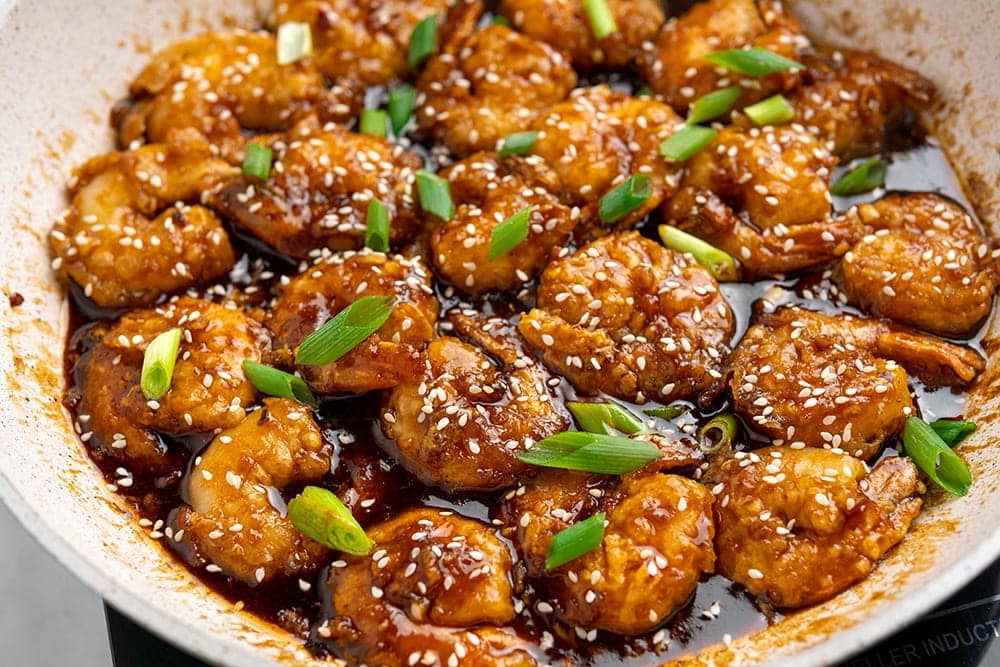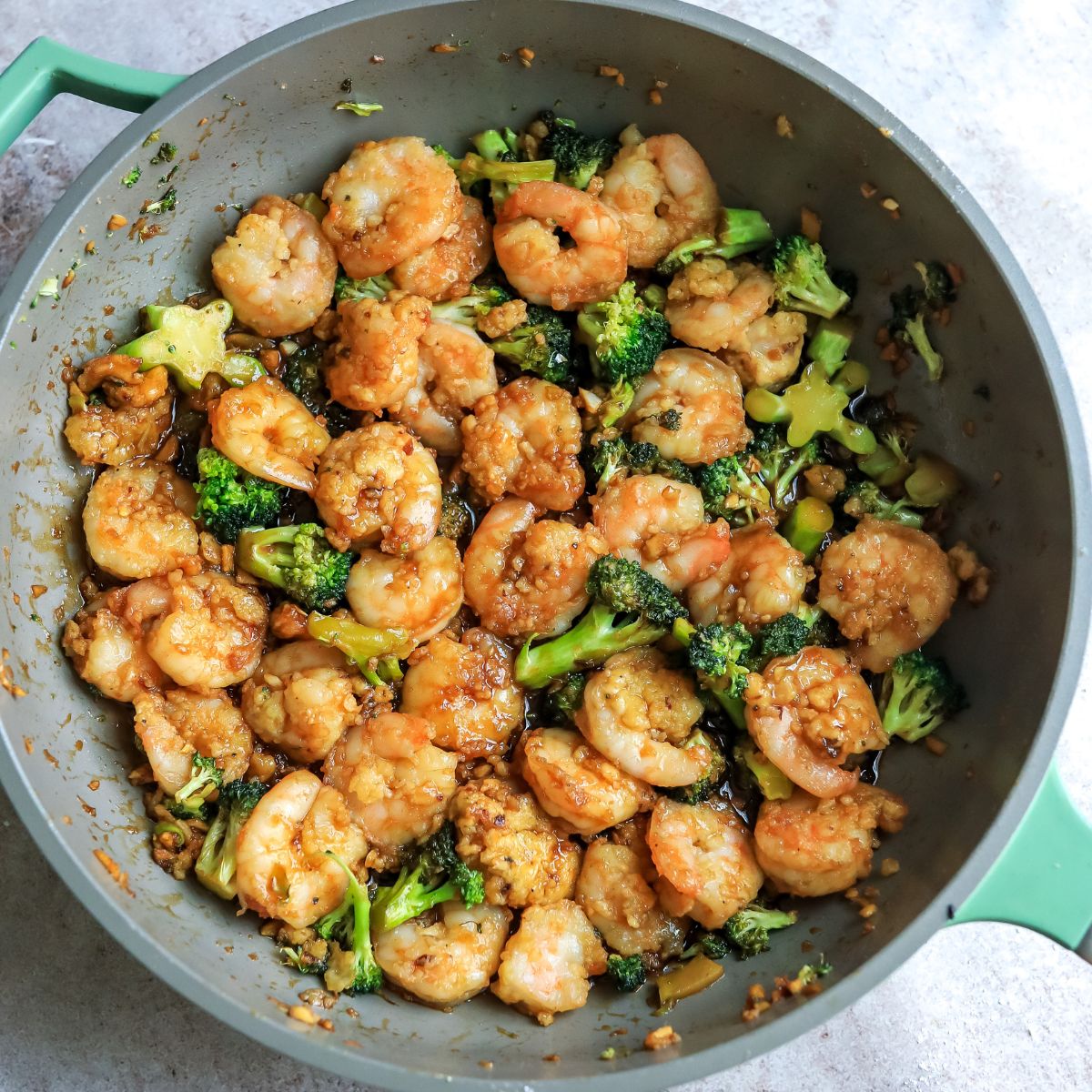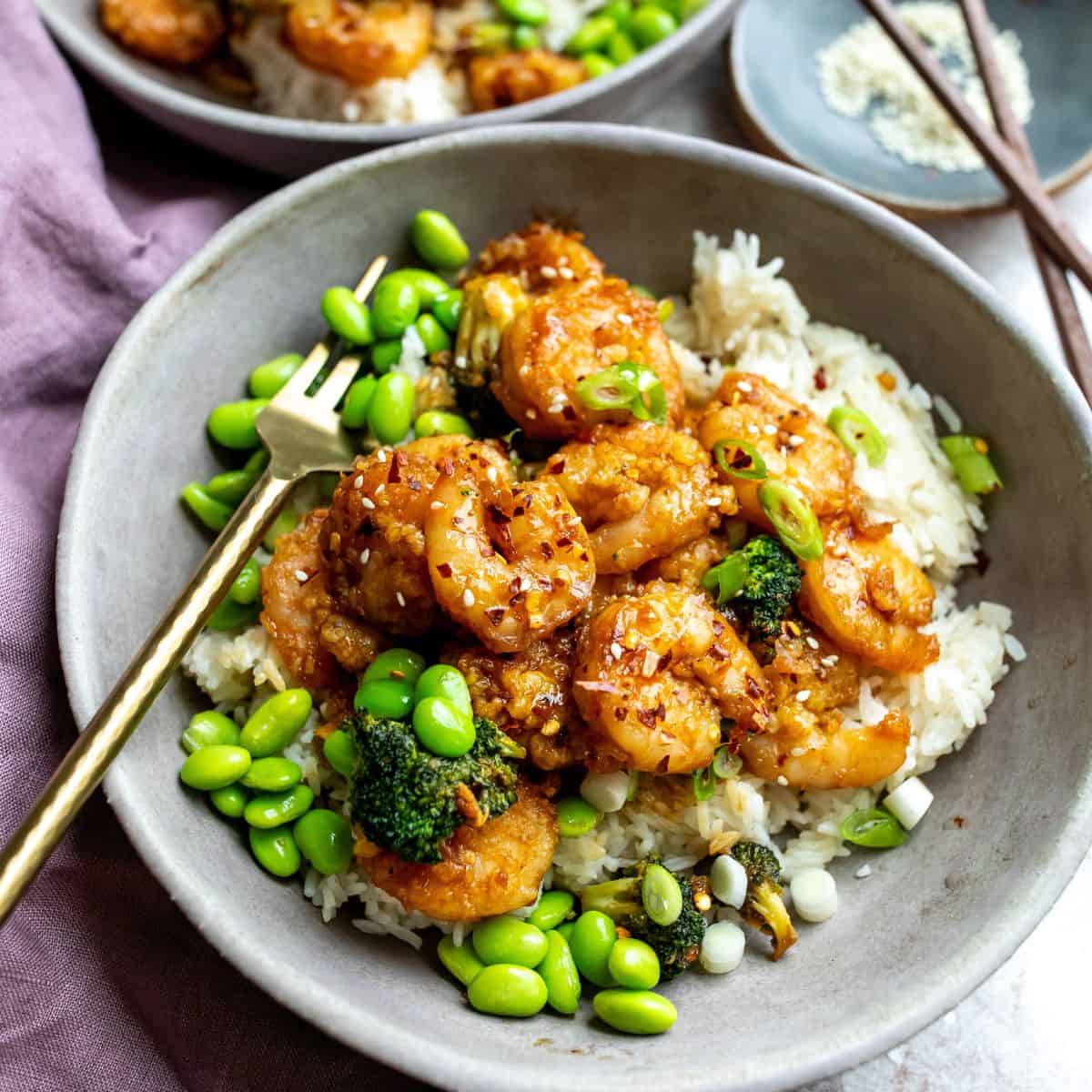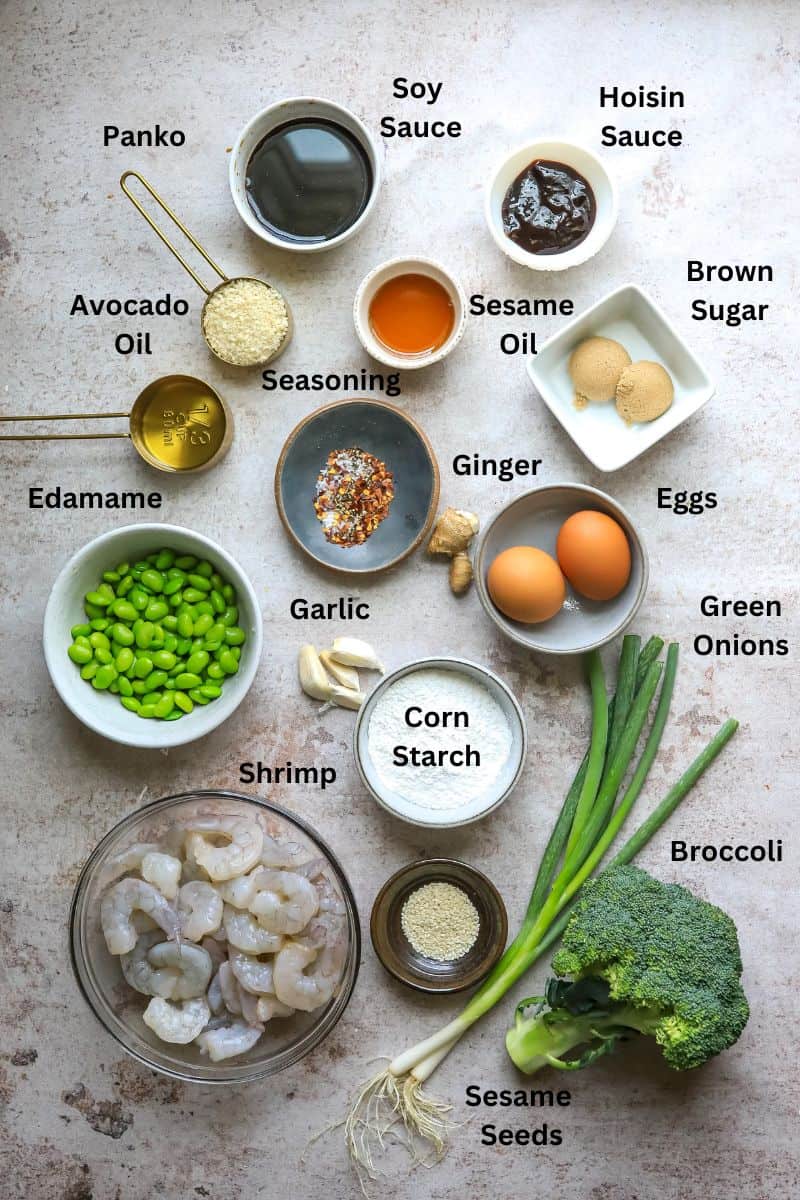For less money and better health, Mongolian shrimp with broccoli is a simple, quick meal that the whole family will love. Ready in 20 minutes.
Mongolian shrimp is a popular Chinese takeout dish that is loaded with flavor yet surprisingly easy to make at home. With its mix of tender shrimp, crunchy vegetables, and savory umami-rich sauce, this stir-fry is a go-to for a quick weeknight meal that still feels special.
In this article, we’ll cover everything you need to know about making restaurant-quality Mongolian shrimp in your own kitchen.
What is Mongolian Shrimp?
Mongolian shrimp is a stir-fry dish that originated in Taiwan, though it is now popular across many regions of China. It features succulent shrimp that are first velveted – meaning they are coated in a mix of egg, cornstarch, and seasonings – then quickly stir-fried in a wok or skillet to seal in moisture.
The velveted shrimp are cooked with traditional Chinese aromatics like ginger, garlic scallions and dried red chilies which provide a big boost of flavor. The shrimp and aromatics are then bathed in a thick, sweet and savory sauce with ingredients like soy sauce, rice wine, brown sugar, and sesame oil.
Broccoli, carrots, bell peppers, or other crisp vegetables are also commonly added to provide texture and color contrast to the tender shrimp. The vegetables soak up the flavorful sauce and make the dish more hearty and filling.
Overall, Mongolian shrimp is the perfect balance of sweet and salty, with pleasant hits of spice and umami. The velvety shrimp contrasts beautifully with the crunchy vegetables and thick, clingy sauce. It’s a dish packed with diverse flavors and textures in each bite!
The Origins and Variations of Mongolian Shrimp
Mongolian shrimp with its signature thick sauce and velveted protein likely originated from the Mongolian beef dish that emerged in Taiwan in the 1950s. Restaurants adapted the popular beef stir-fry to use shrimp instead, playing on the velveting preparation technique that was also gaining popularity at the time.
Today, Mongolian shrimp is a menu staple at many North American Chinese restaurants. However, like many Chinese-American dishes, what we call Mongolian shrimp in the West is quite different from the traditional Mongolian cuisine found in China and Mongolia.
Authentic Mongolian stir-fries use only soy sauce, rice wine, and aromatics for flavor instead of a sticky sauce. The name “Mongolian” refers to the cooking technique of using a round-bottomed wok to stir-fry ingredients over high heat, rather than any specific Mongolian ingredients.
There are also many regional variations of Mongolian shrimp. Versions found in China or Taiwan may use oyster sauce and lack heavy cornstarch thickening. Some restaurants add curry powder or五香粉 (five spice powder). Feel free to play around with the sauce ingredients to suit your tastes!
How to Make Mongolian Shrimp at Home
Now let’s get into how to easily recreate this restaurant favorite in your own kitchen with just a few basic ingredients and steps:
Ingredients
-
Shrimp – peeled, deveined large shrimp
-
Cornstarch and egg – for velveting the shrimp
-
Ginger, garlic, scallions, dried red chilies
-
Soy sauce, rice wine, brown sugar – for the sauce
-
Broccoli, carrots, or other vegetables
-
Sesame oil, white pepper
-
Rice or lo mein noodles
That’s all you need for making delicious Mongolian shrimp loaded with authentic flavor!
Prep the Shrimp
Start by peeling and deveining the shrimp if needed. Rinse the shrimp and pat very dry, as any moisture will impact the velveting process.
To velvet, mix together the cornstarch, egg white, a bit of oil, and white pepper in a bowl. Add the shrimp and toss to evenly coat. This will form a thin, velvety layer that seals in moisture.
Let the coated shrimp sit at room temperature while you prep the remaining ingredients. The cornstarch coating will adhere better at room temperature vs chilled.
Stir-Fry the Aromatics
Next, prep your aromatics – mince the garlic and ginger, slice the scallions, and ready your peppers.
Heat 1 Tbsp oil in a wok or large skillet over high heat. Stir-fry the garlic, ginger, pepper and white parts of the scallions for 30 seconds. They will become very fragrant.
Cook the Shrimp
Push the aromatics to the sides of the wok and add the velveted shrimp in a single layer in the center. Let sit untouched for 30 seconds until the shrimp begin to take on color underneath.
Then, stir-fry for another 1-2 minutes until the shrimp are just cooked through. Don’t overcook, as they will continue to cook off heat.
Remove the cooked shrimp from the wok and set aside.
Make the Sauce
For the sauce, combine the soy sauce, rice wine, brown sugar, and 1/4 cup water in a small bowl.
Return the wok to high heat. When hot, add the sauce mixture and let boil for 1-2 minutes until thickened.
Turn the heat down to low, then stir the cooked shrimp and vegetables back into the wok and toss to coat in the sauce.
Finish and Serve
That’s it! Finish with a drizzle of sesame oil and sprinkle of sliced green onions for garnish.
Serve the Mongolian shrimp immediately over steamed rice or lo mein noodles. Enjoy this flavor-packed shrimp dish just like your favorite Chinese takeout but healthier and made fresh at home.
Tips for the Best Mongolian Shrimp
Here are some top tips to help you nail perfectly tender, flavorful Mongolian shrimp every time:
-
Choose fresh, large shrimp – The quality of shrimp is key. Large shrimp around 16-20 per pound are ideal.
-
Dry shrimp very well – Moisture will make the velvet coating ineffective. Pat off excess water.
-
Use a very hot wok – You need high heat to properly sear and caramelize the velveted shrimp.
-
Don’t overcook – Shrimp overcooks quickly. 1-2 minutes stir-frying is sufficient.
-
Make sure shrimp is coated – Toss vigorously to evenly coat shrimp in sauce.
-
Use fresh ginger and garlic – These aromatics really make the dish. Don’t skip them!
-
Add vegetables – Broccoli, carrots, etc absorb flavor and make it a complete meal.
-
Serve immediately – The texture contrasts are best when served as soon as it’s cooked.
How to Store and Reheat Leftovers
One bonus of homemade Mongolian shrimp is getting leftovers! Here are some tips:
-
Let the stir-fry cool completely before storing in an airtight container in the fridge.
-
Separate the sauce from the shrimp and vegetables to prevent sogginess.
-
Reheat in a skillet over medium heat with a splash of water to loosen the sauce.
-
Alternately, microwave individual portions covered with a damp paper towel.
-
Only reheat the amount you plan to eat. Don’t keep reheating the entire batch.
-
Enjoy leftovers within 3-4 days for the best taste and texture.
More Delicious Shrimp Recipes to Try
Once you’ve mastered quick and easy Mongolian shrimp, try out more classic Chinese shrimp recipes:
-
Kung Pao Shrimp – Spicy stir-fry with peanuts and signature kung pao sauce
-
Honey Walnut Shrimp – Crispy fried shrimp in a sweet creamy glaze
-
Salt and Pepper Shrimp – Wok-seared shrimp tossed in a light batter flavored with black pepper
-
Drunken Shrimp – Shrimp cooked in a broth of Chinese rice wine and aromatics
-
Shrimp with Lobster Sauce – Shrimp and veggies napped in a savory Chinese-style gravy
-
Singapore Noodles – Curry rice noodles studded with shrimp and pork
You really can’t go wrong when shrimp is on the menu. Enjoy experimenting with all the diverse flavors of Chinese cuisine.
Make Mongolian Shrimp at Home Tonight
Mongolian Shrimp is a restaurant favorite that can easily be enjoyed at home any night of the week. Simply velvet the shrimp, stir-fry with classic aromatics, then coat in a sweet savory sauce – that’s all it takes to make this Chinese takeout staple from your own kitchen.
Loaded with tender shrimp, colorful veggies, and intense umami flavors, this is a stir-fry the whole family will love. Plus you can control the ingredients and skip unhealthy oils or excess salt that takeout often contains.
So grab some shrimp and fire up your wok tonight. Happy stir-frying

Steps To Finish Mongolian Shrimp
Step Six. Once the shrimp is finished cooking, add it to a paper towel lined plate. This will soak up excess oil. Keep to the side. In the same pan, wipe it clean if needed with a paper towel. Add in chopped broccoli. Microwave or steam the edamame at this time.

Step Seven. After cooking the broccoli for four minutes, add the sauce and stir it around a lot for three minutes on low heat. Add the shrimp back in and let it get completely covered in the Mongolian sauce.
Step Eight. Add rice to bowls and serve Mongolian shrimp over the rice with edamame. Garnish with green onions, sesame seeds and red pepper flakes.

Sliced bell peppers, jalapeños, carrots or zucchini would also be good.
This dish is pretty mild in flavor. You can skip the red pepper flakes if needed.
It is typically a Taiwan style dish traditionally.
Don’t overcook the shrimp. It can get rubbery if you over cook it. Try to cook it until it’s just light pink all the way through.
If some of the crispy batter falls off in the pan, don’t worry—just mix it in, and enjoy the crispy bits all over.
Make this dish gluten and soy free by using coconut aminos or tamari.
This Mongolian shrimp is great on it’s own but you can certainly pair is with several other dishes. Spring Rolls would be a favorite to pair this with or Spicy Cucumber Salad. I also love it with my Cabbage Salad or Baked Avocado Fries.
Why Make This Mongolian Shrimp
This shrimp is so flavorful. It has a very light batter which gives it a little crunch. Because it’s a light batter, it’s healthier and it’s not deep fried. You won’t miss the calories don’t worry. The sauce does all the heavy lifting.
This meal comes together so quickly, have dinner ready in about 20 minutes. The broccoli and edamame give the dish color and texture. Shrimp is full of protein so this meal will leave you feeling full and satisfied. You can also try my Honey Sriracha Shrimp for another sweet/spicy quick meal.

Shrimp. Be sure to use a high quality shrimp. I go for Large or extra large frozen shrimp that’s cleaned with the tail off.
Corn Starch. This gives the shrimp a nice crisp. It acts as a light batter to the shrimp.
Panko. Panko is in the aisle with bread crumbs. It’s a Japanese bread crumb and a bit crispier than regular bread crumbs. This gives the lightly battered shrimp some crunch and the bowl some crunch all around.
Egg. This is to help stick the cornstarch to the shrimp.
Avocado Oil. I like to fry shrimp in avocado oil because it’s safe to use at high temperatures and doesn’t have a strong flavor. You can use any oil you prefer. The shrimp is’t deep fried, just lightly fried in a skillet.
Hoisin Sauce. This is a sweet, lightly spicy dark sauce. This and soy sauce is the base of the sauce. This sauce is also great in my Beef Fried Rice. This is found in the international aisle in the store.
All other ingredients and measurements can be found below in the recipe card.
Shrimp. You can use chicken but will need to cook the chicken longer until the internal temp is 165º.
Avocado Oil. You can also use vegetable oil.
Cornstarch. Arrowroot or flour will also work well.
Soy Sauce. Tamari or coconut aminos will work for a gluten free/soy free alternative.
Broccoli. Zucchini or sliced bell peppers will also work well.
Mongolian Shrimp Recipe
FAQ
What is Mongolian sauce?
What is the nutritional value of Mongolian shrimp?
What is Hong Sue shrimp?
How do Chinese tenderize shrimp?
